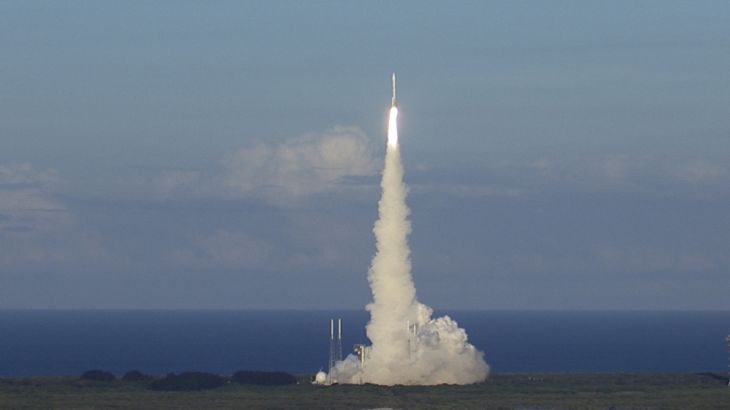Bennu: NASA launches historic asteroid mission
US space agency launches first mission to retrieve dust from asteroid in hopes of learning more about origins of life.

The US space agency has launched its first mission to collect and return dust from an asteroid, in hopes of learning more about the origins of life on Earth, and perhaps elsewhere in the solar system.
The unmanned spacecraft, known as OSIRIS-REx, blasted off from Cape Canaveral in Florida at 23:05 GMT on Thursday, according to NASA.
Keep reading
list of 4 itemsCalifornia firefighters make progress against first large fire of the yearCalifornia firefighters make progress ...
What is ‘All eyes on Rafah’? Decoding a viral social trend on Israel’s warWhat is ‘All eyes on Rafah’? Decoding a ...
A brief history of the traffic light and why we need a new colourA brief history of the traffic light and ...
The space probe is programmed to collect dust from Bennu, a near-Earth asteroid that may have delivered life-giving materials to our planet billions of years ago.
READ MORE: Potential Earth-like planet discovered
Bennu was chosen from the asteroids in the solar system, of which there are about 500,000, because it orbits close to Earth’s path around the Sun, it is the right size for scientific study, and it is one of the oldest asteroids known to NASA.
“Bennu is about 500 metres across and orbits our Sun at a speed of over 28km/s,” Tarek Bazley, Al Jazeera’s science editor, said.
“Once OSIRIS-Rex catches up with the asteroid, it will make a slow and careful approach.”
Once the spacecraft is near Bennu, it will deploy an instrument, not unlike a vacuum cleaner, to suck up samples from the asteroid’s surface, Bazley said.
“It will then begin the return journey to Earth with its precious cargo on board.”
![The spacecraft is expected to reach Bennu in August 2018 and spend two years studying it [NASA]](/wp-content/uploads/2016/09/1d519e00e42949fa9bed958214e1598c_18.jpeg)
Learning more about the origins of life and the beginning of the solar system are the key objectives of the SUV-sized OSIRIS-REx, which stands for Origins, Spectral Interpretation, Resource Identification and Security-Regolith Explorer.
“It’s going to help us understand how the solar system formed,” said Jeffrey Grossman, an OSIRIS-REx programme scientist.
“It’s going to inform our understanding for the potential for life in the solar system; on Earth and elsewhere.”
READ MORE: ExoMars mission sets off to find life on Red Planet
But the mission should also shed light on how to find precious resources such as water and metals in asteroids, a field that has generated increasing interest worldwide.
The spacecraft is expected to reach Bennu in August 2018 and spend two years studying it, before it begins the sample collection attempt in July 2020.
It is expected to return samples to Earth by 2023 for further study.
![NASA hopes OSIRIS-REx will bring back the largest payload of space samples since the Apollo era [Mike Brown/Reuters]](/wp-content/uploads/2016/09/ab05f0f6648342b4a7b34f8c435eabaa_18.jpeg)
Yet, another aim of the mission is to measure how sunlight can nudge asteroids as they orbit, a phenomenon known as the Yarkovsky effect.
This could potentially help scientists to better predict the long-term risk of asteroids such as Bennu colliding with Earth.
|
|
No large asteroids are known to pose any immediate threat to Earth, but new ones are found every year and their orbits can change over time.
“All these missions are important,” Francisco Diego, an astronomer from University College London, told Al Jazeera.
“They are giving us the confidence that we can actually get closer to an asteroid and then start doing something to change the orbit.”
NASA hopes OSIRIS-REx will bring back the largest payload of space samples since the Apollo era of the 1960s and 1970s, when American explorers collected and carried back to Earth some 800 pounds (360kg) of moon rocks.
The spacecraft should pick up about two ounces (60g) from the asteroid, but in tests so far it has generally picked up five times that amount.
Past missions
OSIRIS-REx may be the first of its kind for the NASA, but it was JAXA, the Japanese space agency, that first proved sample collection from an asteroid was possible.
JAXA’s Hayabusa spacecraft crash-landed into the surface of its target asteroid but nevertheless managed to return a few microgrammes of material in 2010.
The Japanese agency launched a follow-up mission, Hayabusa 2, in December 2014. It should reach the asteroid Ryugu in 2018.
The Hayabusa 2 spacecraft will place on the space rock’s surface a small lander named Mascot, produced by the French and German space agencies, and return asteroid samples by 2020.
![The unmanned spacecraft took off from Cape Canaveral in Florida [NASA TV]](/wp-content/uploads/2016/09/1afcd870558b4474a23ba91cbe1412c5_18.jpeg)